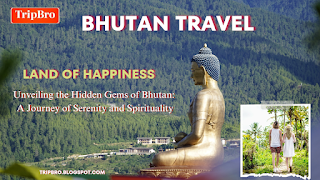The Road Less Travelled
Bhutan is a destination like no other. Its commitment to preserving its unique culture and environment has led to a limited number of visitors each year. It's a place where happiness is measured and promoted through Gross National Happiness, a unique concept that measures well-being, quality of life, and spiritual values.
Tiger's Nest Monastery: A Stairway to Spirituality
The Tiger's Nest Monastery, perched on the edge of a cliff, is an iconic image of Bhutan. The gruelling trek to reach this sacred site is not for the faint of heart, but the reward is immense. It's a place where you can witness the harmonious blend of Buddhism and nature.
Tiger's Nest Monastery, or Paro Taktsang, is a breathtaking religious site nestled in the Himalayan mountains of Bhutan. Perched on the edge of a steep cliff, this iconic structure is a symbol of Bhutanese Buddhism and a testament to the country's rich cultural heritage. Legend has it that Guru Rinpoche, the second Buddha, flew to this location on the back of a tigress, which adds to its mystique. The monastery is a remarkable feat of architecture and devotion, consisting of several temples and meditation caves. Visiting this sacred site offers not only spiritual insight but also unparalleled views of the pristine Himalayan landscape.
Paro: A Timeless Valley
Paro is a charming town surrounded by lush greenery, traditional architecture, and a serene river. Its scenic beauty combined with the famous Paro Tsechu festival, which celebrates the arrival of Guru Rinpoche, will immerse you in Bhutan's rich culture.
Paro Valley is a picturesque gem in the heart of Bhutan, enveloped by lush green mountains and meandering rivers. It serves as the gateway to this Himalayan kingdom, home to Bhutan's only international airport. The valley boasts an enchanting landscape with terraced fields, traditional Bhutanese houses, and a serene atmosphere. Paro is renowned for its cultural richness, housing many historic monasteries, temples, and dzongs, such as the impressive Rinpung Dzong. The highlight of the valley is the iconic Tiger's Nest Monastery, perched on a cliff's edge. Paro Valley's charm lies in its blend of natural beauty, cultural heritage, and the warm hospitality of its people, making it a must-visit destination in Bhutan.
Punakha Dzong: The Palace of Great Happiness
Punakha Dzong, known as the "Palace of Great Happiness," is one of Bhutan's most majestic structures. It's strategically located at the confluence of two rivers and is a fine example of Bhutanese architecture. This place truly embodies the country's spiritual and cultural heritage.
Punakha Dzong, also known as the Pungthang Dewa Chenbi Phodrang, is one of Bhutan's most beautiful and historically significant fortresses. Situated at the confluence of the Pho Chhu (father) and Mo Chhu (mother) rivers, it served as the former capital of Bhutan. The dzong is an architectural marvel, with towering whitewashed walls, golden roofs, and intricate woodwork. It's famous for its striking beauty and serene location.
Punakha Dzong is not just a visual delight; it's a crucial religious and administrative center in Bhutan. It houses numerous sacred relics, and the sacred Mochhu Cham, a religious dance, is performed here annually. The dzong also plays a significant role in the country's governance, hosting the coronation of Bhutan's kings.
Visiting Punakha Dzong allows you to witness Bhutan's rich history, culture, and stunning craftsmanship in one magnificent setting.
The Valley of Phobjikha: A Sanctuary for Black-Necked Cranes
The pristine valley of Phobjikha is not only a visual treat with its sweeping landscapes but also a haven for the rare and endangered Black-Necked Cranes. Witnessing these graceful birds in their natural habitat is a humbling experience.
The Phobjikha Valley, often referred to as Gangteng Valley, is a glacial valley in central Bhutan. It is renowned for its natural beauty and significance as a conservation area for the endangered black-necked cranes that migrate to the region during the winter months.
Phobjikha Valley is a pristine and tranquil destination, characterized by vast open spaces, lush forests, and traditional Bhutanese farmhouses. The Gangtey Monastery, perched on a hilltop, adds a cultural dimension to the valley. Visitors can enjoy scenic hikes, explore the rich biodiversity, and learn about the local culture.
The valley's conservation efforts and commitment to preserving its unique environment make it a special place in Bhutan, attracting both nature enthusiasts and those interested in Bhutan's ecological and cultural heritage.
Unique Cuisine: Ema Datshi and Beyond
Bhutanese cuisine is a delightful adventure for your taste buds. Ema Datshi, a spicy chilli and cheese dish, is a must-try. While Bhutanese food may not be as widely known as its neighbouring countries, it is a revelation of flavours.
Bhutanese cuisine is known for its unique flavors and use of spices. Rice is a staple, and dishes often feature chili peppers, cheese, and meat. Ema Datshi, a spicy chili and cheese stew, is a national favorite. Momos, dumplings filled with various ingredients, are also popular. The cuisine reflects the country's culture and traditions, with an emphasis on simple, hearty, and flavorful dishes.
Why Bhutan become popular
Bhutan's untouched beauty and commitment to preserving its culture and environment have made it a viral sensation among travellers. In the age of overtourism, this kingdom has found a way to balance tourism with its core values, and the world is taking note.
The travel article encapsulates the magic of Bhutan, a place where serenity and spirituality are at the forefront. It's a destination that not only went viral for its beauty but also for the values it upholds, making it a must-visit for any traveller seeking an authentic and transformative experience.





